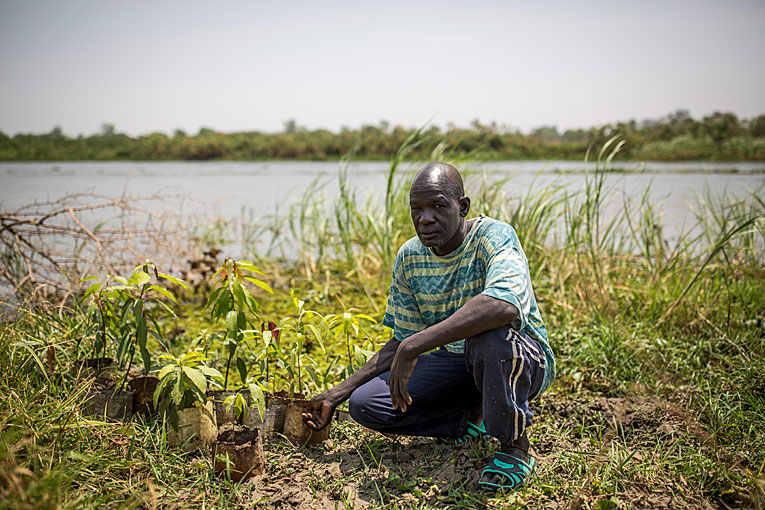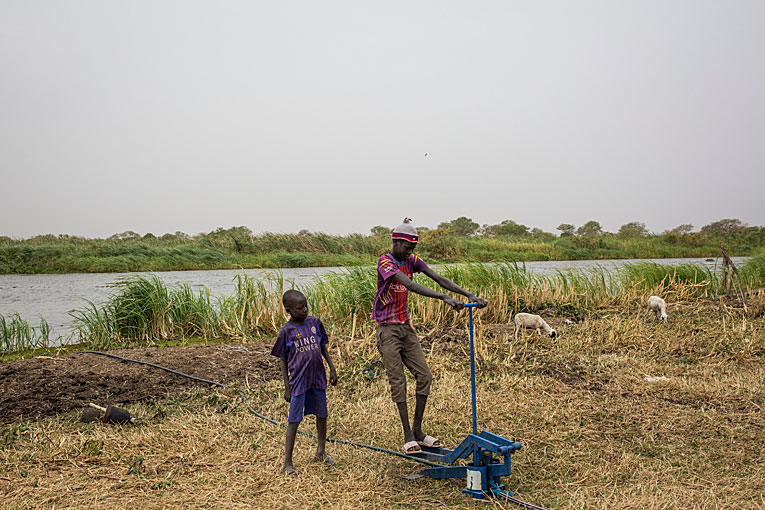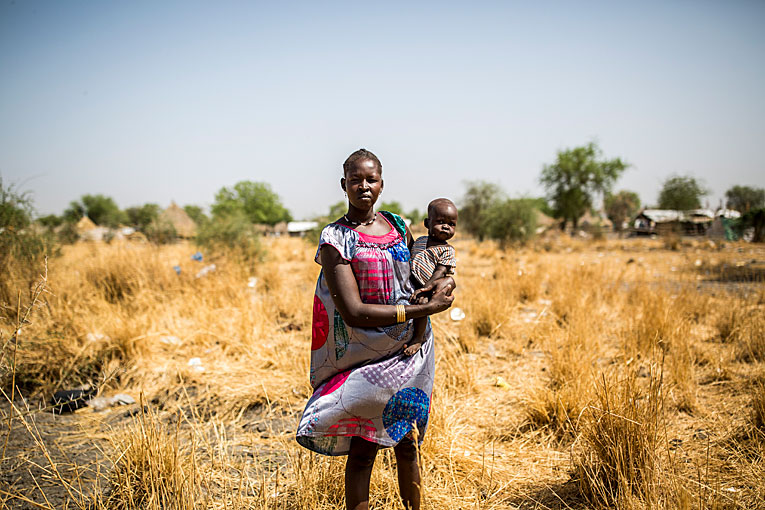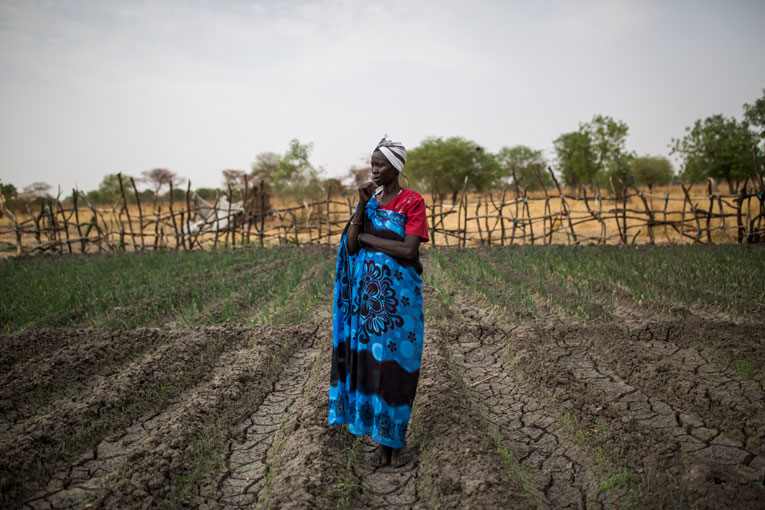Swamp offered shelter from war in South Sudan – “The worst part of the journey was hunger”
The region of al-Sudd in South Sudan is one of the biggest swamps in the world. The region has offered a refuge for people escaping the war. During the hardest times of the war, people waded through wetlands, risking running into crocodiles and snakes, and ate water lily fruits to stay alive.
OLD FANGAK, SOUTH SUDAN. The little mango trees sprouting promising shoots in Samuel Gony Gori’s pots are a veritable miracle, considering the cracking soil surrounding the 50-year-old farmer’s land, and the unbearable, nearly 40-Celsius heat in Old Fangak in the daytime.
Samuel waters his plants with water from nearby Zeraf River. Working the foot-operated water pump may be hard work, but it keeps his hope of a successful crop alive. The mangoes require care, and without the water pump, farming would be impossible during the dry season.
“In the harvest seasons, I sell a lot of produce at the market, and with my savings, my family can enjoy two good meals a day. My income is even enough to pay for the children’s clothing.”
Fangak is located in the north, near the border with Sudan. The peace negotiated last autumn is a reality here, but the soil is unrelenting and farming is hard. In the south of the country, the region of Equatoria – located on the Equator – is known as the breadbasket of South Sudan, and a saying originating from there goes, “If you throw a seed in the ground, it grows into a giant mango tree.” Nevertheless, farmers have left Equatoria because of the fighting still going on in the region.

Samuel Gony Gory grows mango trees.
Samuel radiates the confidence of a person who has overcome the worst. His family witnessed the painful turns of the South Sudanese civil war. Two years ago, they were in the middle of a famine caused by the fighting in the small town of Bentiu in neighbouring Unity State.
“There was absolutely nothing to eat. First I stopped farming because of the constant gunfire. Then our relatives started to disappear, and we decided to seek shelter here,” recalls Samuel.

The water pump has caught the interest of the youngest in the village.
The swamp region of al-Sudd is one of the biggest in the world. The name is Arabic and means “barrier.” The swamp is so difficult to cross that back in the days when explorers were searching for the source of the White Nile, they got stuck in the wetlands of al-Sudd.
Old Fangak is a former British garrison town whose old buildings were destroyed in the civil war. The population mostly consists of Nuer people, the archrivals of the Dinka people represented by President Salva Kiir.
During the civil war, Old Fangak became a haven for refugees. While in 2013, the population was 5,000, last year the number was up to almost 50,000.
The soldiers did not think it was worth the trouble to brave the swamp, the inner parts of which can only be reached by boat via Zeraf River, an arm of the White Nile, or by plane – that is, unless you are running for your life. Families seeking shelter from fighting and famine have escaped soldiers by treading through the swamp despite crocodiles and poisonous snakes.
In the deepest parts of the swamp, adults carried children on their shoulders.
“The worst part of the journey was hunger,” says Samuel. His family survived the journey that took a month by eating the fruits of water lilies.
“It’s hard to say whether it was hunger or bullets that killed them.”
“Many people who fled at the same time as we did had been starving for so long that their strength had ran out. We were forced to leave people behind as the soldiers found us time after time,” recalls Samuel.
“It’s hard to say whether it was hunger or bullets that killed them.”
In June 2017, the UN declared that the famine was over, but since then, the situation has only gotten worse.
In February 2019, the UN estimated that over six million people live in acute food shortage. That is more than half of the South Sudanese population. About 1.5 million are on the brink of famine.
“Peace is a prerequisite for any improvement in the situation,” says Moses Habib, humanitarian coordinator for FCA. The peace deal has raised optimism, but the people who left their homes are still too afraid to return.
At the same time, international aid is decreasing at an alarming rate.
“Initiating self-sufficient food production takes time. Food aid is still vital so that people have the energy to think further ahead than until the meal for the next day,” says Habib.

Nyarom Jiech Chuol is a single mother with seven children.
In the midmorning, the Zeraf River’s boat traffic flows towards the market in downtown Old Fangak.
Canoes are carved from coconut tree trunks. The precious fish are shielded from the sun with grass. Fish is cheaper than meat, and the catch does not always reach the market before being sold.
Mother of seven, Nyarom Jiech Chuol, buys a bunch of tilapia at the market for about two euros.
“I provide for my children by collecting firewood and I sleep through the night in peace, without gunfire,” says Nyarom. She ran from the fighting in Bentium that led to famine.
FCA has assisted 1,000 farmers and 500 fishermen in the Old Fangak area by providing seeds, water pumps, nets, hooks, and education. In addition, 1,000 families have received cash assistance. FCA also supports 30 schools in Fangak, with over 16,000 pupils.
The huts made out of waterproof tarpaulins and bamboo represent the population of the region. Many internally displaced persons use the tarpaulins given out by aid organisations, while the locals have roofs made of grass or tin.
The repercussions of the war can be seen at the market. In wait of the next crop, the selection of vegetables on offer is nonexistent. Onions cost half a euro a piece. Before the war, one euro was enough to feed a family for a day, now the prices are tenfold. Food production is insufficient, inflation is out of control, and imported food is expensive.
Nyarom has received cash assistance from FCA in every three months. The assistance of about 50 euros brings variety to her children’s diet. Nyarom says that she saw with her own eyes where the food shortage began.
“It started when we had to leave our cultivations and our livestock. Both cattle and people were burned alive in their clay huts,” she says.

Elizabeth Gal is a dedicated farmer.
Because of how isolated it is, Old Fangak depends on the goods delivered from capital Juba via the Nile. Before the peace deal in September, the goods often did not make it past the checkpoints along the way.
Now, the route is easier to travel. However, there is still too little food because of the fighting still going on in Equatoria.
According to Habib, improving the situation in Equatoria is crucial. At present, over one million people have fled the region and crossed the border to Uganda, and the parties who did not sign the peace deal continue to fight.
“Without peace, people won’t return to their crops, and without food, there is no steady foundation for peace,” says Habib.
Nevertheless, the Nile deliveries have provided farmers with more seeds and tools. Next to Samuel’s crops, 43-year-old Elizabeth Gal waits for a new hose for her water pump.
The furrows in her plot of land are as straight as a pin, but the field is completely dry and cracked because the hose is too short to reach the field from the river.
“As long as I have the seeds and tools, I can do anything,” she assures us.
Translation: Leena Vuolteenaho
Text: Erik Nyström
Photos: Patrick Meinhardt